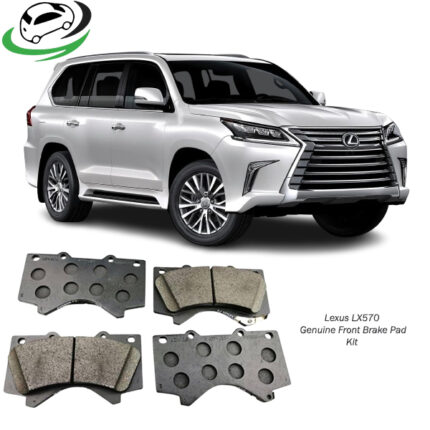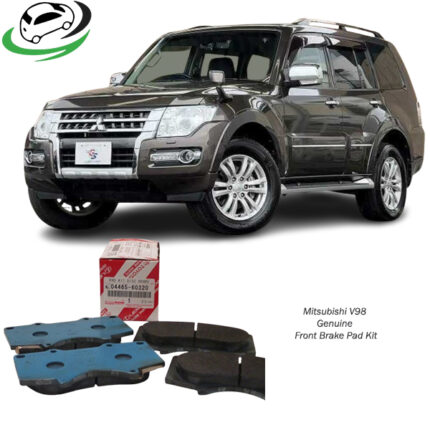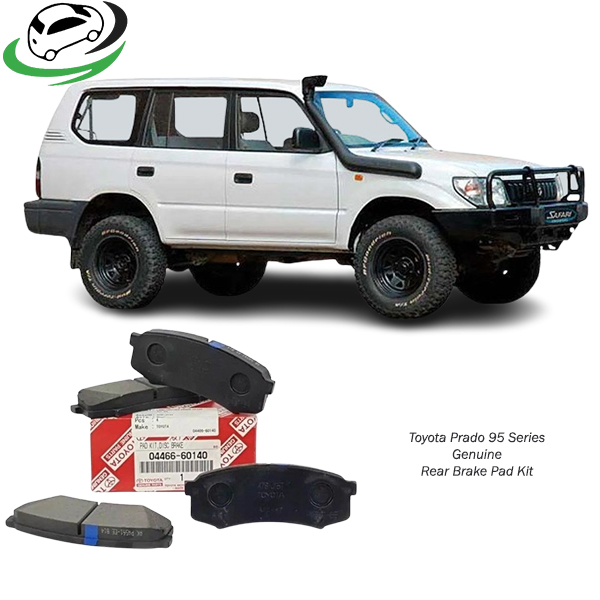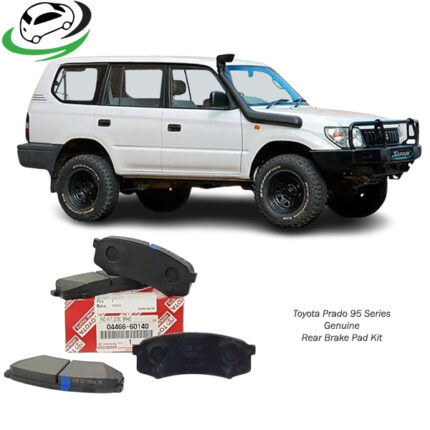-9%
Get Toyota Prado 95 Series Genuine Rear Brake Pad Kit 0446660140
A genuine rear brake pad kit is an essential component in a vehicle’s braking system. It ensures optimal braking performance, safety, and longevity of other related brake components. Brake pads work by creating friction against the brake rotor, slowing down the wheel’s rotation and ultimately bringing the vehicle to a halt. In this detailed explanation, we’ll explore the function of rear brake pads, the significance of using genuine parts, types of materials used, benefits, maintenance tips, and signs of wear.
Function of Rear Brake Pads
The primary role of rear brake pads is to create the necessary friction to stop or decelerate the vehicle. When you press the brake pedal, hydraulic pressure is generated in the brake master cylinder, which is transferred to the brake calipers at each wheel. The calipers then clamp the brake pads against the rotor, creating friction. This friction converts the vehicle’s kinetic energy into heat, slowing the vehicle down.
Rear brake pads typically endure less pressure compared to the front pads, since most of the braking force is applied to the front wheels. However, their role in the overall braking system is crucial, especially in maintaining vehicle stability, distributing braking forces, and supporting systems like Anti-lock Braking Systems (ABS).
Importance of Using Genuine Brake Pads
Using genuine rear brake pads ensures compatibility, quality, and reliability. Genuine brake pads are manufactured to meet the vehicle manufacturer’s original specifications. Here are several reasons why using genuine brake pads is vital:
- Perfect Fit and Performance: Genuine brake pads are designed to fit specific vehicle models, ensuring precise performance and reducing the risk of malfunction. Non-genuine or aftermarket parts might not provide the same fit, which can affect the braking efficiency.
- Longevity and Durability: Original parts undergo rigorous testing to ensure they last longer and withstand harsh driving conditions. Genuine pads are made with materials that provide consistent wear and tear, extending the life of the rotor and other brake components.
- Enhanced Safety: Genuine parts maintain the integrity of the braking system. Since they meet the manufacturer’s safety standards, they ensure that your vehicle stops effectively, reducing the risk of brake failure, which could lead to accidents.
- Warranty Protection: Many vehicle manufacturers offer warranties on their parts, including brake pads. Using non-genuine parts might void your warranty, leaving you unprotected in case of a malfunction or failure.
Types of Materials Used in Brake Pads
Brake pads can be made from various materials, each offering different levels of performance, durability, and braking power. There are three primary types of brake pad materials used in vehicles:
- Ceramic Brake Pads: Ceramic brake pads are made from a mixture of ceramic fibers, non-ferrous materials, and bonding agents. These pads are known for their longevity and performance. They generate less dust, offer quieter braking, and have a high resistance to heat. However, they tend to be more expensive and might not perform as well in extreme braking situations, such as in heavy-duty or high-performance vehicles.
- Semi-Metallic Brake Pads: Semi-metallic pads contain a mixture of metals like copper, steel, iron, and other materials. These pads are highly durable and offer excellent braking performance, especially in high-temperature conditions. They are typically noisier and produce more brake dust compared to ceramic pads. Semi-metallic pads are popular for heavy-duty and high-performance vehicles.
- Organic Brake Pads: Made from organic materials such as rubber, carbon, and fiberglass, these pads are softer and quieter. They tend to wear out faster compared to ceramic or semi-metallic pads and are better suited for lighter vehicles with lower braking demands. Organic pads are often more affordable, but they can generate more dust and perform poorly under intense conditions.
Benefits of Genuine Rear Brake Pads
- Optimal Performance: Genuine pads deliver consistent performance in a variety of conditions, from daily driving to heavy braking. Since they are tested to meet specific vehicle requirements, they provide efficient stopping power under normal and emergency conditions.
- Longevity of Components: When genuine pads are used, they help protect the brake rotors and other components from premature wear. Non-genuine pads might have uneven wear rates, which can damage the rotors or calipers, resulting in costly repairs.
- Noise Reduction: Genuine brake pads are designed with anti-noise features such as built-in shims or insulation layers that prevent squealing or grinding noises during braking.
- Heat Management: Rear brake pads are exposed to significant heat during braking. Genuine pads are made with materials that efficiently dissipate heat, reducing the risk of brake fade and extending the life of the pad.
- Dust Control: Genuine rear brake pads produce less brake dust, keeping your wheels cleaner and reducing the need for frequent maintenance. Excessive brake dust can affect the appearance of the vehicle and damage the wheels if not regularly cleaned.
- Brake Balance: Genuine pads ensure that the front and rear braking systems are balanced, preventing uneven braking forces that could lead to instability, especially during sudden stops.
Maintenance Tips for Rear Brake Pads
Proper maintenance is essential for extending the life of your rear brake pads and ensuring the overall performance of your braking system. Here are some key maintenance tips:
- Regular Inspections: Inspect your rear brake pads every 10,000 to 15,000 miles or whenever you notice signs of wear. A visual inspection can reveal whether the pads are wearing evenly, and measuring their thickness can indicate when a replacement is needed.
- Brake Fluid Check: Brake pads rely on hydraulic pressure, so it’s important to regularly check the brake fluid levels. Low or contaminated brake fluid can affect the efficiency of the braking system.
- Rotating Tires: Rotating your tires can help distribute the braking forces more evenly across all wheels, preventing premature wear of the rear brake pads.
- Gentle Braking: Avoid aggressive braking unless absolutely necessary. Hard braking increases heat and wear, which shortens the lifespan of the pads. Smooth, gradual braking helps maintain the efficiency and life of your brake pads.
- Cleaning and Dust Removal: Brake dust can accumulate on the pads and rotors, reducing their effectiveness. Regularly cleaning the wheels and brake components can prevent dust buildup and extend the life of the brake pads.
- Address Noises Immediately: If you hear any unusual noises such as squealing or grinding, have the brake pads inspected immediately. These noises often indicate worn-out pads or other brake issues.
Signs of Worn-Out Rear Brake Pads
Knowing when your rear brake pads need replacement is crucial to maintaining safety and performance. Here are common signs that your brake pads may be worn out:
- Squealing or Screeching Noises: High-pitched squealing sounds while braking usually indicate that the pads have worn down to a level where the wear indicator is making contact with the rotor.
- Grinding Sound: A grinding noise suggests that the brake pads are completely worn, and the metal backing is rubbing against the rotor. This can lead to significant damage to the rotor and caliper if not addressed immediately.
- Reduced Braking Power: If you notice that it takes longer to stop your vehicle, or the brake pedal feels soft or spongy, it could be a sign of worn brake pads or low brake fluid levels.
- Vibration During Braking: If you feel vibrations or pulsing in the brake pedal while braking, it could indicate uneven wear of the brake pads or warped rotors.
- Brake Warning Light: Some vehicles are equipped with a brake pad warning system. If the brake light comes on, it’s a clear indication that your brake pads need to be checked.
Conclusion
A genuine rear brake pad kit is essential for maintaining the integrity and safety of your vehicle’s braking system. Choosing genuine parts over aftermarket alternatives ensures compatibility, reliability, and optimal performance. Regular inspections, maintenance, and knowing the signs of worn-out pads will help you keep your brake system in top shape, ensuring your vehicle stops safely and efficiently every time.
Follow us on Facebook for more parts.





Reviews
Clear filtersThere are no reviews yet.